Organisational Behaviour at Sainsbury's: Culture, Power and Motivation
VerifiedAdded on 2024/05/23
|31
|6351
|126
Report
AI Summary
This report provides a comprehensive analysis of organisational behaviour within Sainsbury's, focusing on the influence of culture, politics, and power on individual and team performance. It evaluates content and process theories of motivation, including Maslow's hierarchy of needs, Herzberg's two-factor theory, and McClelland's needs theory, and examines how these theories and motivational techniques contribute to goal achievement. The report also explores the characteristics of effective teams and analyses team development theories, such as Tuckman's stages of group development, to support dynamic cooperation. Furthermore, it justifies and evaluates various concepts and philosophies related to organisational behaviour, considering both positive and negative influences on behaviour within the organisational context. Desklib provides access to similar solved assignments and past papers for students.

ORGANISATIONAL BEHAVIOUR
Paraphrase This Document
Need a fresh take? Get an instant paraphrase of this document with our AI Paraphraser
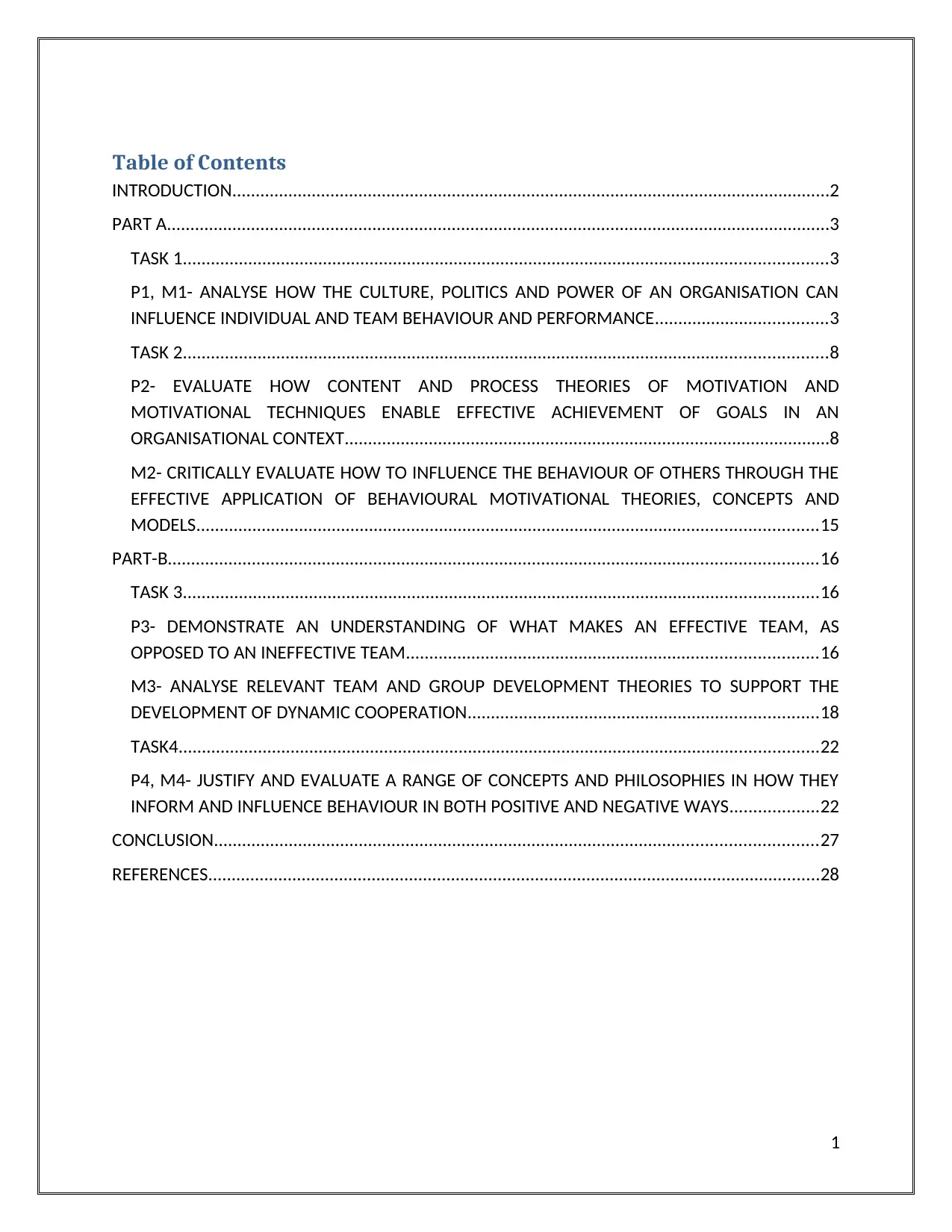
Table of Contents
INTRODUCTION................................................................................................................................2
PART A..............................................................................................................................................3
TASK 1..........................................................................................................................................3
P1, M1- ANALYSE HOW THE CULTURE, POLITICS AND POWER OF AN ORGANISATION CAN
INFLUENCE INDIVIDUAL AND TEAM BEHAVIOUR AND PERFORMANCE.....................................3
TASK 2..........................................................................................................................................8
P2- EVALUATE HOW CONTENT AND PROCESS THEORIES OF MOTIVATION AND
MOTIVATIONAL TECHNIQUES ENABLE EFFECTIVE ACHIEVEMENT OF GOALS IN AN
ORGANISATIONAL CONTEXT........................................................................................................8
M2- CRITICALLY EVALUATE HOW TO INFLUENCE THE BEHAVIOUR OF OTHERS THROUGH THE
EFFECTIVE APPLICATION OF BEHAVIOURAL MOTIVATIONAL THEORIES, CONCEPTS AND
MODELS.....................................................................................................................................15
PART-B...........................................................................................................................................16
TASK 3........................................................................................................................................16
P3- DEMONSTRATE AN UNDERSTANDING OF WHAT MAKES AN EFFECTIVE TEAM, AS
OPPOSED TO AN INEFFECTIVE TEAM........................................................................................16
M3- ANALYSE RELEVANT TEAM AND GROUP DEVELOPMENT THEORIES TO SUPPORT THE
DEVELOPMENT OF DYNAMIC COOPERATION...........................................................................18
TASK4.........................................................................................................................................22
P4, M4- JUSTIFY AND EVALUATE A RANGE OF CONCEPTS AND PHILOSOPHIES IN HOW THEY
INFORM AND INFLUENCE BEHAVIOUR IN BOTH POSITIVE AND NEGATIVE WAYS...................22
CONCLUSION.................................................................................................................................27
REFERENCES...................................................................................................................................28
1
INTRODUCTION................................................................................................................................2
PART A..............................................................................................................................................3
TASK 1..........................................................................................................................................3
P1, M1- ANALYSE HOW THE CULTURE, POLITICS AND POWER OF AN ORGANISATION CAN
INFLUENCE INDIVIDUAL AND TEAM BEHAVIOUR AND PERFORMANCE.....................................3
TASK 2..........................................................................................................................................8
P2- EVALUATE HOW CONTENT AND PROCESS THEORIES OF MOTIVATION AND
MOTIVATIONAL TECHNIQUES ENABLE EFFECTIVE ACHIEVEMENT OF GOALS IN AN
ORGANISATIONAL CONTEXT........................................................................................................8
M2- CRITICALLY EVALUATE HOW TO INFLUENCE THE BEHAVIOUR OF OTHERS THROUGH THE
EFFECTIVE APPLICATION OF BEHAVIOURAL MOTIVATIONAL THEORIES, CONCEPTS AND
MODELS.....................................................................................................................................15
PART-B...........................................................................................................................................16
TASK 3........................................................................................................................................16
P3- DEMONSTRATE AN UNDERSTANDING OF WHAT MAKES AN EFFECTIVE TEAM, AS
OPPOSED TO AN INEFFECTIVE TEAM........................................................................................16
M3- ANALYSE RELEVANT TEAM AND GROUP DEVELOPMENT THEORIES TO SUPPORT THE
DEVELOPMENT OF DYNAMIC COOPERATION...........................................................................18
TASK4.........................................................................................................................................22
P4, M4- JUSTIFY AND EVALUATE A RANGE OF CONCEPTS AND PHILOSOPHIES IN HOW THEY
INFORM AND INFLUENCE BEHAVIOUR IN BOTH POSITIVE AND NEGATIVE WAYS...................22
CONCLUSION.................................................................................................................................27
REFERENCES...................................................................................................................................28
1

INTRODUCTION
Organizational behaviour can be defined as the study that shows the attitude or perception of
the people and also depicts the way to interact with other people within the organization. It is
the approach that is applied for a better understanding of management system of the
enterprise. It improves the level of performances and works according to enhance the
proficiency. It is the viable part of the organization in order to create a healthy environment
and effective working culture so that it would be easier to gain competitive advantages with the
relevance of benefit accordingly. In this assignment, influences of power, culture and politics on
the personal behaviour of people will describe that covers the area of team performances and
level of their working criteria. Further, motivational techniques and theories will describe that
plays an important role in encouraging the people according to their certain working criteria So
that they can do their work effectively towards the accomplishment of goals. In the end, team
development and concepts of organizational behaviour will describe that can influence the level
of performances.
The chosen organization for this assignment is Sainsbury's that is largest supermarket chain in
the UK, was founded in 1869. It provides various kinds of services and products to the people
and helps them to fulfil their needs accordingly.
2
Organizational behaviour can be defined as the study that shows the attitude or perception of
the people and also depicts the way to interact with other people within the organization. It is
the approach that is applied for a better understanding of management system of the
enterprise. It improves the level of performances and works according to enhance the
proficiency. It is the viable part of the organization in order to create a healthy environment
and effective working culture so that it would be easier to gain competitive advantages with the
relevance of benefit accordingly. In this assignment, influences of power, culture and politics on
the personal behaviour of people will describe that covers the area of team performances and
level of their working criteria. Further, motivational techniques and theories will describe that
plays an important role in encouraging the people according to their certain working criteria So
that they can do their work effectively towards the accomplishment of goals. In the end, team
development and concepts of organizational behaviour will describe that can influence the level
of performances.
The chosen organization for this assignment is Sainsbury's that is largest supermarket chain in
the UK, was founded in 1869. It provides various kinds of services and products to the people
and helps them to fulfil their needs accordingly.
2
⊘ This is a preview!⊘
Do you want full access?
Subscribe today to unlock all pages.

Trusted by 1+ million students worldwide
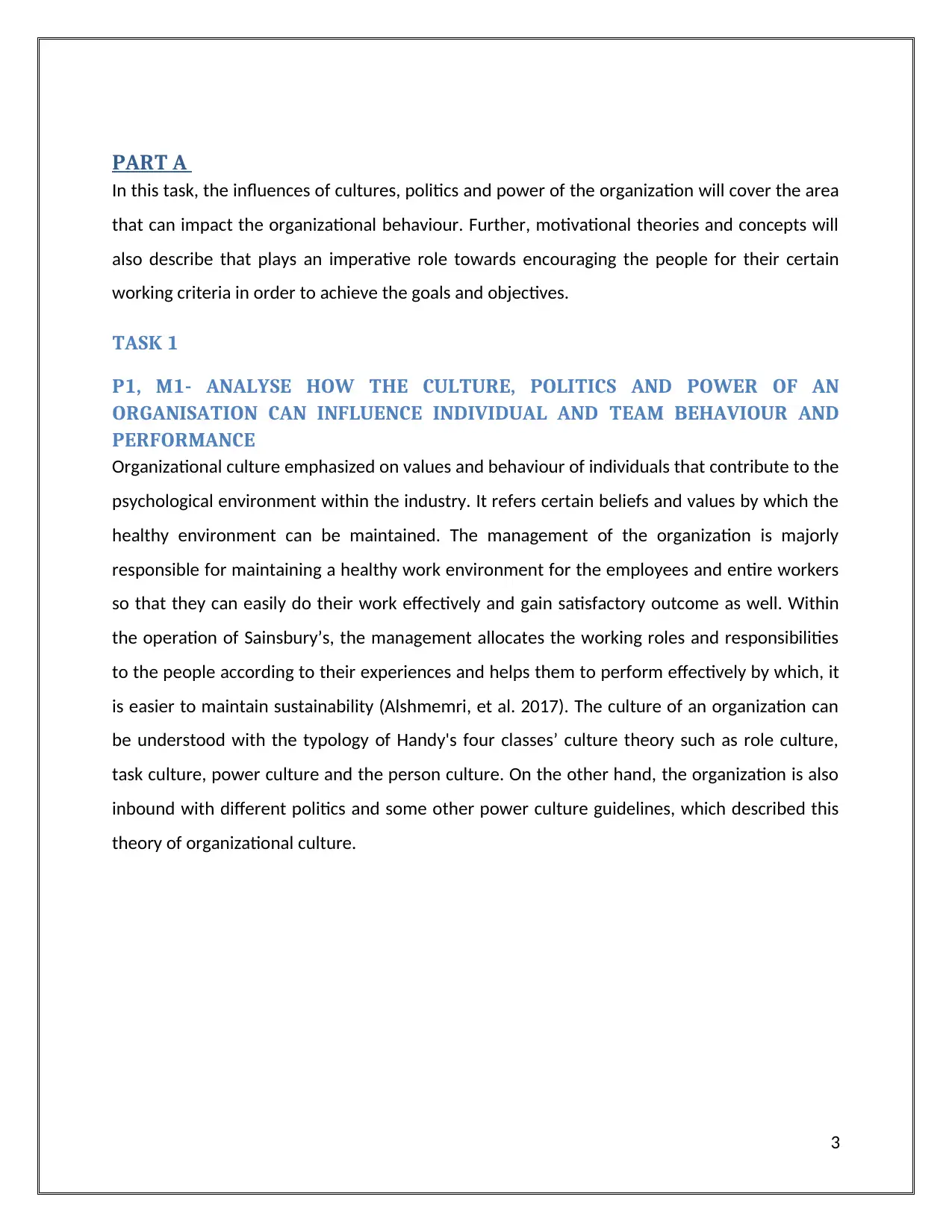
PART A
In this task, the influences of cultures, politics and power of the organization will cover the area
that can impact the organizational behaviour. Further, motivational theories and concepts will
also describe that plays an imperative role towards encouraging the people for their certain
working criteria in order to achieve the goals and objectives.
TASK 1
P1, M1- ANALYSE HOW THE CULTURE, POLITICS AND POWER OF AN
ORGANISATION CAN INFLUENCE INDIVIDUAL AND TEAM BEHAVIOUR AND
PERFORMANCE
Organizational culture emphasized on values and behaviour of individuals that contribute to the
psychological environment within the industry. It refers certain beliefs and values by which the
healthy environment can be maintained. The management of the organization is majorly
responsible for maintaining a healthy work environment for the employees and entire workers
so that they can easily do their work effectively and gain satisfactory outcome as well. Within
the operation of Sainsbury’s, the management allocates the working roles and responsibilities
to the people according to their experiences and helps them to perform effectively by which, it
is easier to maintain sustainability (Alshmemri, et al. 2017). The culture of an organization can
be understood with the typology of Handy's four classes’ culture theory such as role culture,
task culture, power culture and the person culture. On the other hand, the organization is also
inbound with different politics and some other power culture guidelines, which described this
theory of organizational culture.
3
In this task, the influences of cultures, politics and power of the organization will cover the area
that can impact the organizational behaviour. Further, motivational theories and concepts will
also describe that plays an imperative role towards encouraging the people for their certain
working criteria in order to achieve the goals and objectives.
TASK 1
P1, M1- ANALYSE HOW THE CULTURE, POLITICS AND POWER OF AN
ORGANISATION CAN INFLUENCE INDIVIDUAL AND TEAM BEHAVIOUR AND
PERFORMANCE
Organizational culture emphasized on values and behaviour of individuals that contribute to the
psychological environment within the industry. It refers certain beliefs and values by which the
healthy environment can be maintained. The management of the organization is majorly
responsible for maintaining a healthy work environment for the employees and entire workers
so that they can easily do their work effectively and gain satisfactory outcome as well. Within
the operation of Sainsbury’s, the management allocates the working roles and responsibilities
to the people according to their experiences and helps them to perform effectively by which, it
is easier to maintain sustainability (Alshmemri, et al. 2017). The culture of an organization can
be understood with the typology of Handy's four classes’ culture theory such as role culture,
task culture, power culture and the person culture. On the other hand, the organization is also
inbound with different politics and some other power culture guidelines, which described this
theory of organizational culture.
3
Paraphrase This Document
Need a fresh take? Get an instant paraphrase of this document with our AI Paraphraser

Figure: Handy’s four classes culture
[Source: https://www.tutor2u.net/business/reference/models-of-organisational-culture-handy]
Power culture: it is defined as the power within the organization that is held by an individual,
who can be able to monitor the performances and sets the strategies accordingly. There are
various kinds of rules and regulations proposed by the employees in order to set the strategies
for development and growth accordingly. In this culture, some of the people have the authority
to take relevant decisions that can be subordinate by others as well (Anning-Dorson, 2016). It is
one of the strongest cultures. Equal rights have been also given to the staff members according
to their role that can be helpful to maintain sustainability and healthy environment.
Task culture: when the team is formed within the organization, then it has been classified
among the group of members. The top management level of the organization allocates the
different task to the members according to their experiences and working criteria. As team
working criteria is very helpful and improves the level of performances accordingly. It is formed
to accomplish the desired goals and objectives with common goal interest. This type of culture
needs coordination among the workers so that they can maintain sustainability and easily
determine dynamic with the proper skills, leadership traits and other relevant personalities
accordingly.
4
[Source: https://www.tutor2u.net/business/reference/models-of-organisational-culture-handy]
Power culture: it is defined as the power within the organization that is held by an individual,
who can be able to monitor the performances and sets the strategies accordingly. There are
various kinds of rules and regulations proposed by the employees in order to set the strategies
for development and growth accordingly. In this culture, some of the people have the authority
to take relevant decisions that can be subordinate by others as well (Anning-Dorson, 2016). It is
one of the strongest cultures. Equal rights have been also given to the staff members according
to their role that can be helpful to maintain sustainability and healthy environment.
Task culture: when the team is formed within the organization, then it has been classified
among the group of members. The top management level of the organization allocates the
different task to the members according to their experiences and working criteria. As team
working criteria is very helpful and improves the level of performances accordingly. It is formed
to accomplish the desired goals and objectives with common goal interest. This type of culture
needs coordination among the workers so that they can maintain sustainability and easily
determine dynamic with the proper skills, leadership traits and other relevant personalities
accordingly.
4
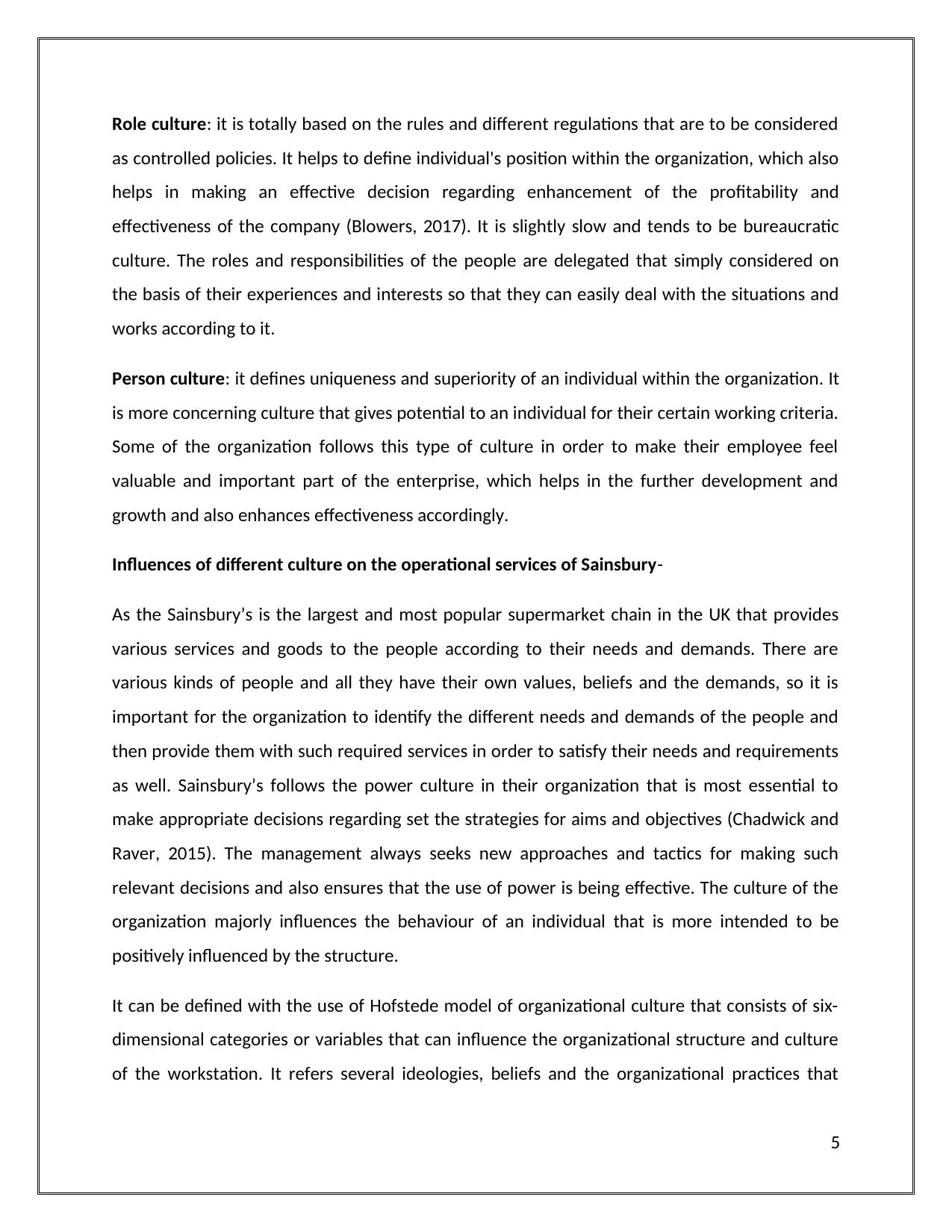
Role culture: it is totally based on the rules and different regulations that are to be considered
as controlled policies. It helps to define individual's position within the organization, which also
helps in making an effective decision regarding enhancement of the profitability and
effectiveness of the company (Blowers, 2017). It is slightly slow and tends to be bureaucratic
culture. The roles and responsibilities of the people are delegated that simply considered on
the basis of their experiences and interests so that they can easily deal with the situations and
works according to it.
Person culture: it defines uniqueness and superiority of an individual within the organization. It
is more concerning culture that gives potential to an individual for their certain working criteria.
Some of the organization follows this type of culture in order to make their employee feel
valuable and important part of the enterprise, which helps in the further development and
growth and also enhances effectiveness accordingly.
Influences of different culture on the operational services of Sainsbury-
As the Sainsbury’s is the largest and most popular supermarket chain in the UK that provides
various services and goods to the people according to their needs and demands. There are
various kinds of people and all they have their own values, beliefs and the demands, so it is
important for the organization to identify the different needs and demands of the people and
then provide them with such required services in order to satisfy their needs and requirements
as well. Sainsbury’s follows the power culture in their organization that is most essential to
make appropriate decisions regarding set the strategies for aims and objectives (Chadwick and
Raver, 2015). The management always seeks new approaches and tactics for making such
relevant decisions and also ensures that the use of power is being effective. The culture of the
organization majorly influences the behaviour of an individual that is more intended to be
positively influenced by the structure.
It can be defined with the use of Hofstede model of organizational culture that consists of six-
dimensional categories or variables that can influence the organizational structure and culture
of the workstation. It refers several ideologies, beliefs and the organizational practices that
5
as controlled policies. It helps to define individual's position within the organization, which also
helps in making an effective decision regarding enhancement of the profitability and
effectiveness of the company (Blowers, 2017). It is slightly slow and tends to be bureaucratic
culture. The roles and responsibilities of the people are delegated that simply considered on
the basis of their experiences and interests so that they can easily deal with the situations and
works according to it.
Person culture: it defines uniqueness and superiority of an individual within the organization. It
is more concerning culture that gives potential to an individual for their certain working criteria.
Some of the organization follows this type of culture in order to make their employee feel
valuable and important part of the enterprise, which helps in the further development and
growth and also enhances effectiveness accordingly.
Influences of different culture on the operational services of Sainsbury-
As the Sainsbury’s is the largest and most popular supermarket chain in the UK that provides
various services and goods to the people according to their needs and demands. There are
various kinds of people and all they have their own values, beliefs and the demands, so it is
important for the organization to identify the different needs and demands of the people and
then provide them with such required services in order to satisfy their needs and requirements
as well. Sainsbury’s follows the power culture in their organization that is most essential to
make appropriate decisions regarding set the strategies for aims and objectives (Chadwick and
Raver, 2015). The management always seeks new approaches and tactics for making such
relevant decisions and also ensures that the use of power is being effective. The culture of the
organization majorly influences the behaviour of an individual that is more intended to be
positively influenced by the structure.
It can be defined with the use of Hofstede model of organizational culture that consists of six-
dimensional categories or variables that can influence the organizational structure and culture
of the workstation. It refers several ideologies, beliefs and the organizational practices that
5
⊘ This is a preview!⊘
Do you want full access?
Subscribe today to unlock all pages.

Trusted by 1+ million students worldwide

have the power to set the strategies. This model provides valuable insight of the organizational
culture.
Figure: Hofstede Model of organizational culture
[Source: https://www.tutor2u.net/business/reference/hofstedes-national-cultures]
Individualism v Collectivism: there are some of the people who strongly relies on the team
working category that is based on the satisfactory outcome and interest of working as per the
ideas, technical terms and another scenario.
Power distance: In this criterion, the responsibilities and power have been equally distributed
to each of the members that refer healthy working culture and gives potential to the workers
towards their certain working criteria accordingly.
Long-term orientation: there are various kinds of people within the workplace who make long-
term decisions and focuses on the steady approach. The people are more concern about their
working criteria and also manages the relationship with each other effectively that will helps in
the enhancement of profitability and effectiveness as well (Christina, et al. 2014). They first set
the long-term target and then make the plan for gaining competitive advantages generating
more revenue accordingly. This type of organizational culture helps the people to retain goals
and also maintains sustainability within the workstation.
6
culture.
Figure: Hofstede Model of organizational culture
[Source: https://www.tutor2u.net/business/reference/hofstedes-national-cultures]
Individualism v Collectivism: there are some of the people who strongly relies on the team
working category that is based on the satisfactory outcome and interest of working as per the
ideas, technical terms and another scenario.
Power distance: In this criterion, the responsibilities and power have been equally distributed
to each of the members that refer healthy working culture and gives potential to the workers
towards their certain working criteria accordingly.
Long-term orientation: there are various kinds of people within the workplace who make long-
term decisions and focuses on the steady approach. The people are more concern about their
working criteria and also manages the relationship with each other effectively that will helps in
the enhancement of profitability and effectiveness as well (Christina, et al. 2014). They first set
the long-term target and then make the plan for gaining competitive advantages generating
more revenue accordingly. This type of organizational culture helps the people to retain goals
and also maintains sustainability within the workstation.
6
Paraphrase This Document
Need a fresh take? Get an instant paraphrase of this document with our AI Paraphraser
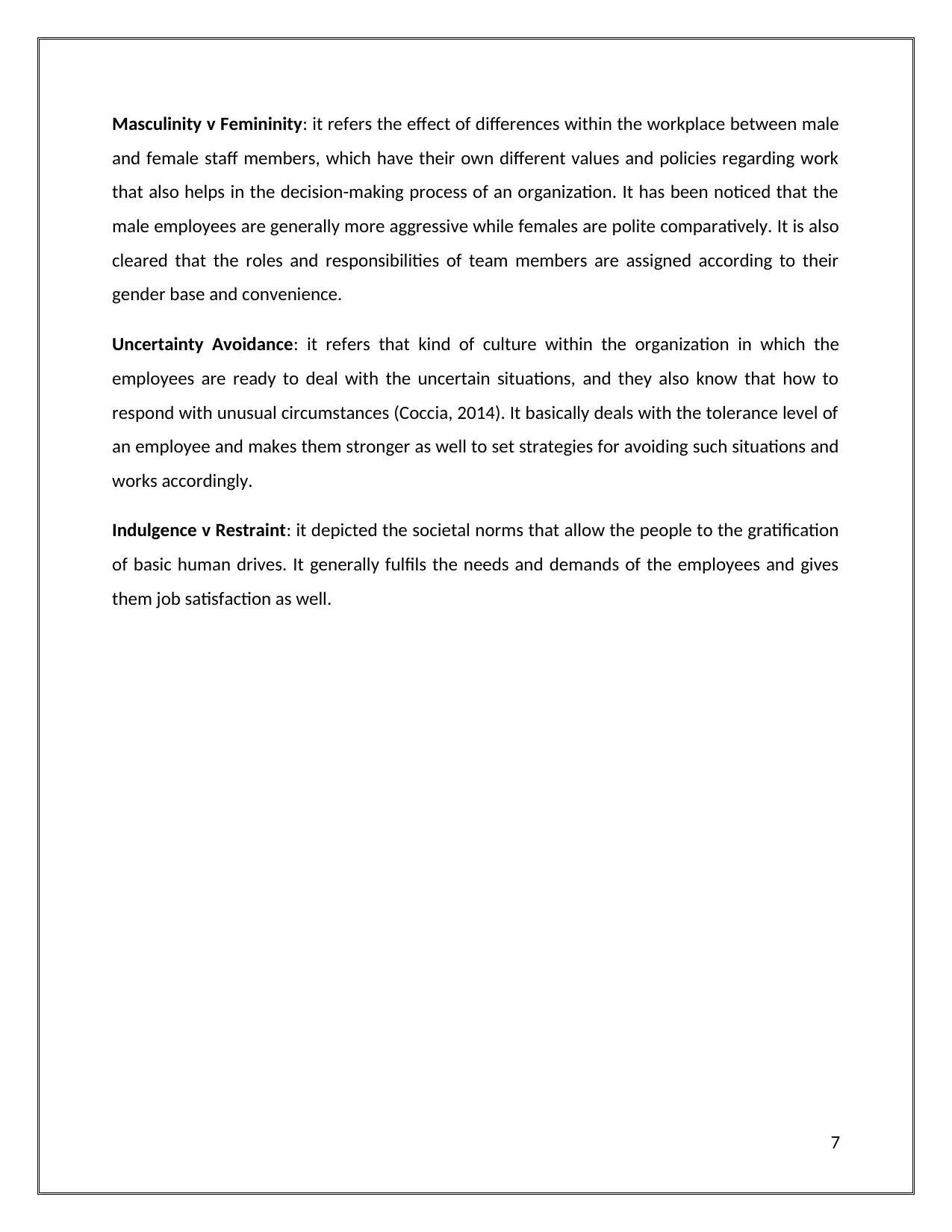
Masculinity v Femininity: it refers the effect of differences within the workplace between male
and female staff members, which have their own different values and policies regarding work
that also helps in the decision-making process of an organization. It has been noticed that the
male employees are generally more aggressive while females are polite comparatively. It is also
cleared that the roles and responsibilities of team members are assigned according to their
gender base and convenience.
Uncertainty Avoidance: it refers that kind of culture within the organization in which the
employees are ready to deal with the uncertain situations, and they also know that how to
respond with unusual circumstances (Coccia, 2014). It basically deals with the tolerance level of
an employee and makes them stronger as well to set strategies for avoiding such situations and
works accordingly.
Indulgence v Restraint: it depicted the societal norms that allow the people to the gratification
of basic human drives. It generally fulfils the needs and demands of the employees and gives
them job satisfaction as well.
7
and female staff members, which have their own different values and policies regarding work
that also helps in the decision-making process of an organization. It has been noticed that the
male employees are generally more aggressive while females are polite comparatively. It is also
cleared that the roles and responsibilities of team members are assigned according to their
gender base and convenience.
Uncertainty Avoidance: it refers that kind of culture within the organization in which the
employees are ready to deal with the uncertain situations, and they also know that how to
respond with unusual circumstances (Coccia, 2014). It basically deals with the tolerance level of
an employee and makes them stronger as well to set strategies for avoiding such situations and
works accordingly.
Indulgence v Restraint: it depicted the societal norms that allow the people to the gratification
of basic human drives. It generally fulfils the needs and demands of the employees and gives
them job satisfaction as well.
7
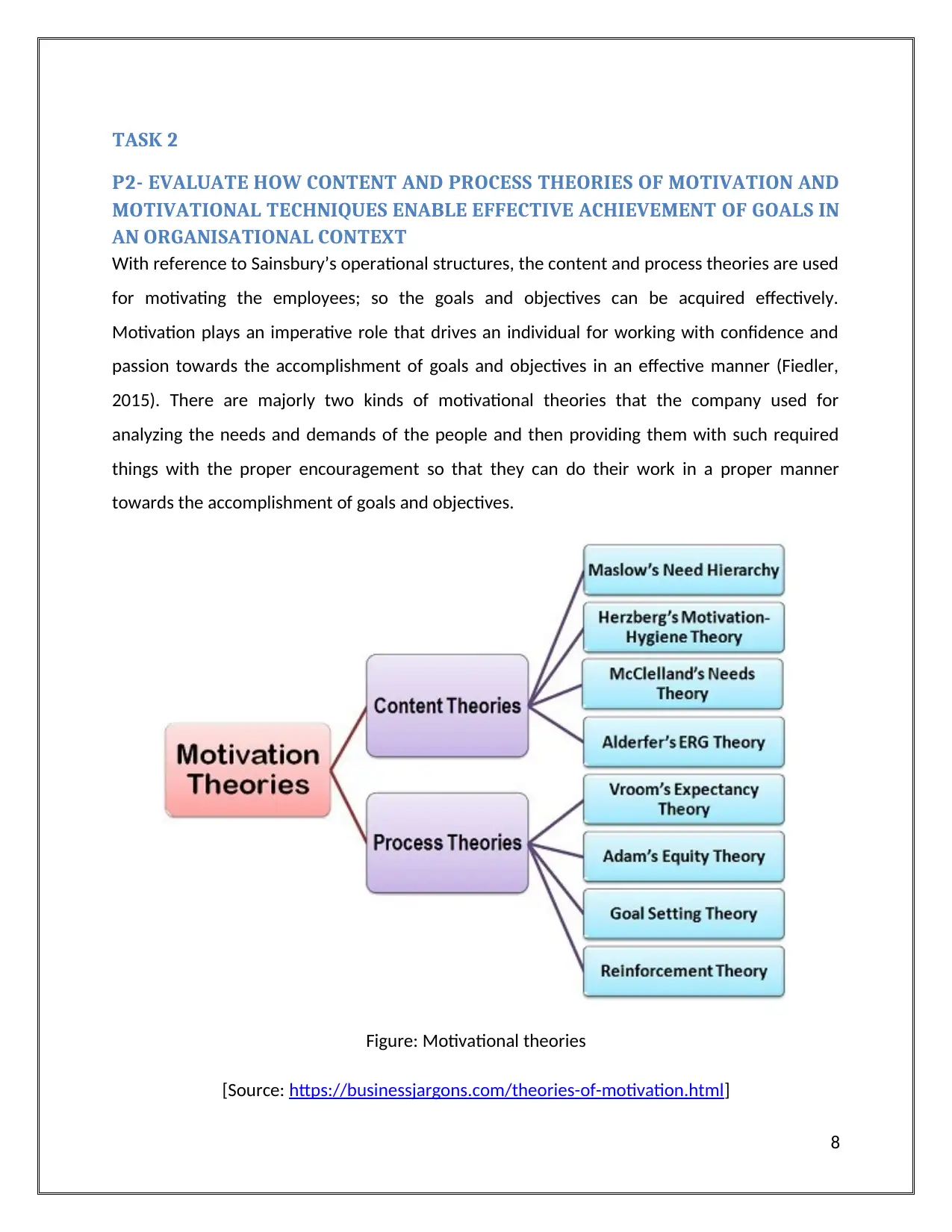
TASK 2
P2- EVALUATE HOW CONTENT AND PROCESS THEORIES OF MOTIVATION AND
MOTIVATIONAL TECHNIQUES ENABLE EFFECTIVE ACHIEVEMENT OF GOALS IN
AN ORGANISATIONAL CONTEXT
With reference to Sainsbury’s operational structures, the content and process theories are used
for motivating the employees; so the goals and objectives can be acquired effectively.
Motivation plays an imperative role that drives an individual for working with confidence and
passion towards the accomplishment of goals and objectives in an effective manner (Fiedler,
2015). There are majorly two kinds of motivational theories that the company used for
analyzing the needs and demands of the people and then providing them with such required
things with the proper encouragement so that they can do their work in a proper manner
towards the accomplishment of goals and objectives.
Figure: Motivational theories
[Source: https://businessjargons.com/theories-of-motivation.html]
8
P2- EVALUATE HOW CONTENT AND PROCESS THEORIES OF MOTIVATION AND
MOTIVATIONAL TECHNIQUES ENABLE EFFECTIVE ACHIEVEMENT OF GOALS IN
AN ORGANISATIONAL CONTEXT
With reference to Sainsbury’s operational structures, the content and process theories are used
for motivating the employees; so the goals and objectives can be acquired effectively.
Motivation plays an imperative role that drives an individual for working with confidence and
passion towards the accomplishment of goals and objectives in an effective manner (Fiedler,
2015). There are majorly two kinds of motivational theories that the company used for
analyzing the needs and demands of the people and then providing them with such required
things with the proper encouragement so that they can do their work in a proper manner
towards the accomplishment of goals and objectives.
Figure: Motivational theories
[Source: https://businessjargons.com/theories-of-motivation.html]
8
⊘ This is a preview!⊘
Do you want full access?
Subscribe today to unlock all pages.

Trusted by 1+ million students worldwide
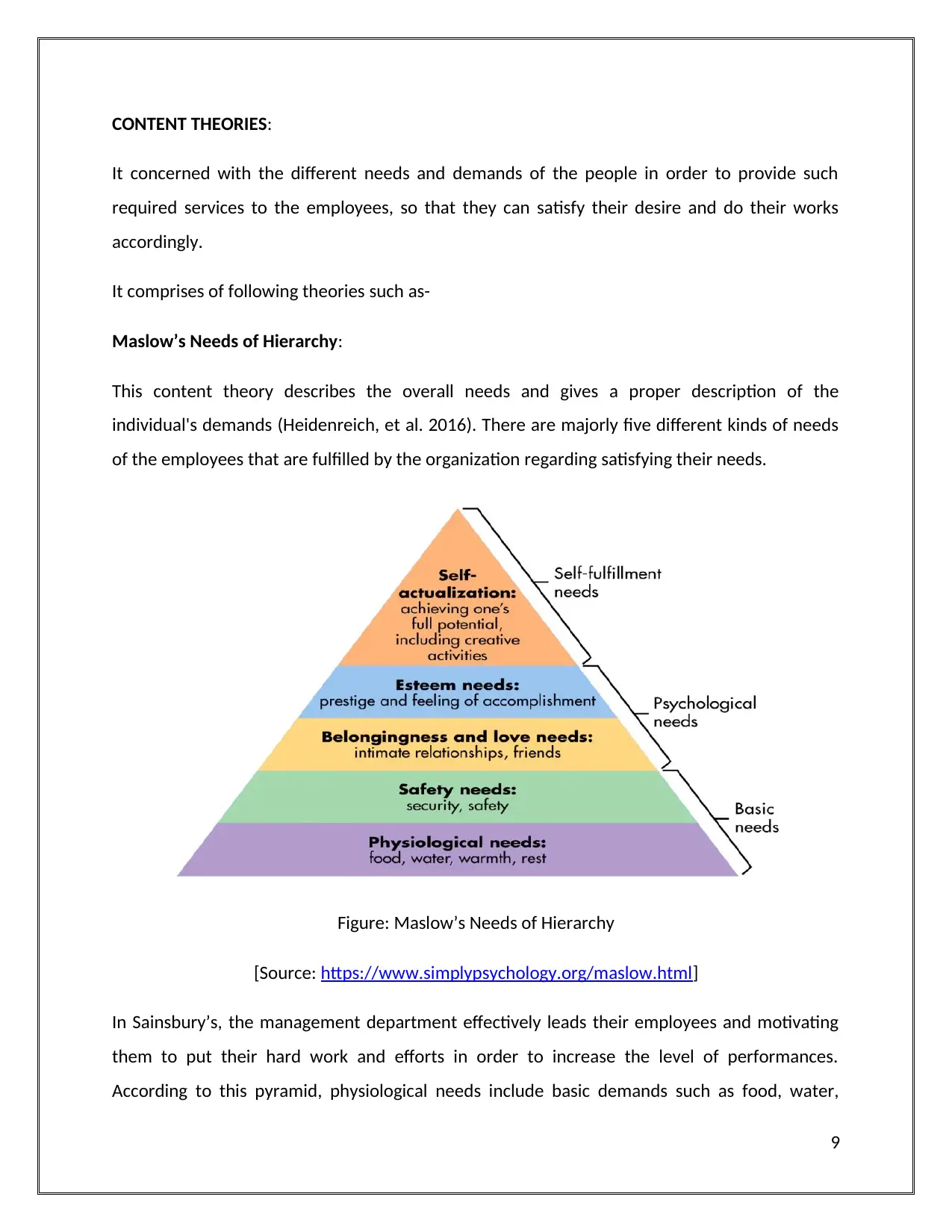
CONTENT THEORIES:
It concerned with the different needs and demands of the people in order to provide such
required services to the employees, so that they can satisfy their desire and do their works
accordingly.
It comprises of following theories such as-
Maslow’s Needs of Hierarchy:
This content theory describes the overall needs and gives a proper description of the
individual's demands (Heidenreich, et al. 2016). There are majorly five different kinds of needs
of the employees that are fulfilled by the organization regarding satisfying their needs.
Figure: Maslow’s Needs of Hierarchy
[Source: https://www.simplypsychology.org/maslow.html]
In Sainsbury’s, the management department effectively leads their employees and motivating
them to put their hard work and efforts in order to increase the level of performances.
According to this pyramid, physiological needs include basic demands such as food, water,
9
It concerned with the different needs and demands of the people in order to provide such
required services to the employees, so that they can satisfy their desire and do their works
accordingly.
It comprises of following theories such as-
Maslow’s Needs of Hierarchy:
This content theory describes the overall needs and gives a proper description of the
individual's demands (Heidenreich, et al. 2016). There are majorly five different kinds of needs
of the employees that are fulfilled by the organization regarding satisfying their needs.
Figure: Maslow’s Needs of Hierarchy
[Source: https://www.simplypsychology.org/maslow.html]
In Sainsbury’s, the management department effectively leads their employees and motivating
them to put their hard work and efforts in order to increase the level of performances.
According to this pyramid, physiological needs include basic demands such as food, water,
9
Paraphrase This Document
Need a fresh take? Get an instant paraphrase of this document with our AI Paraphraser
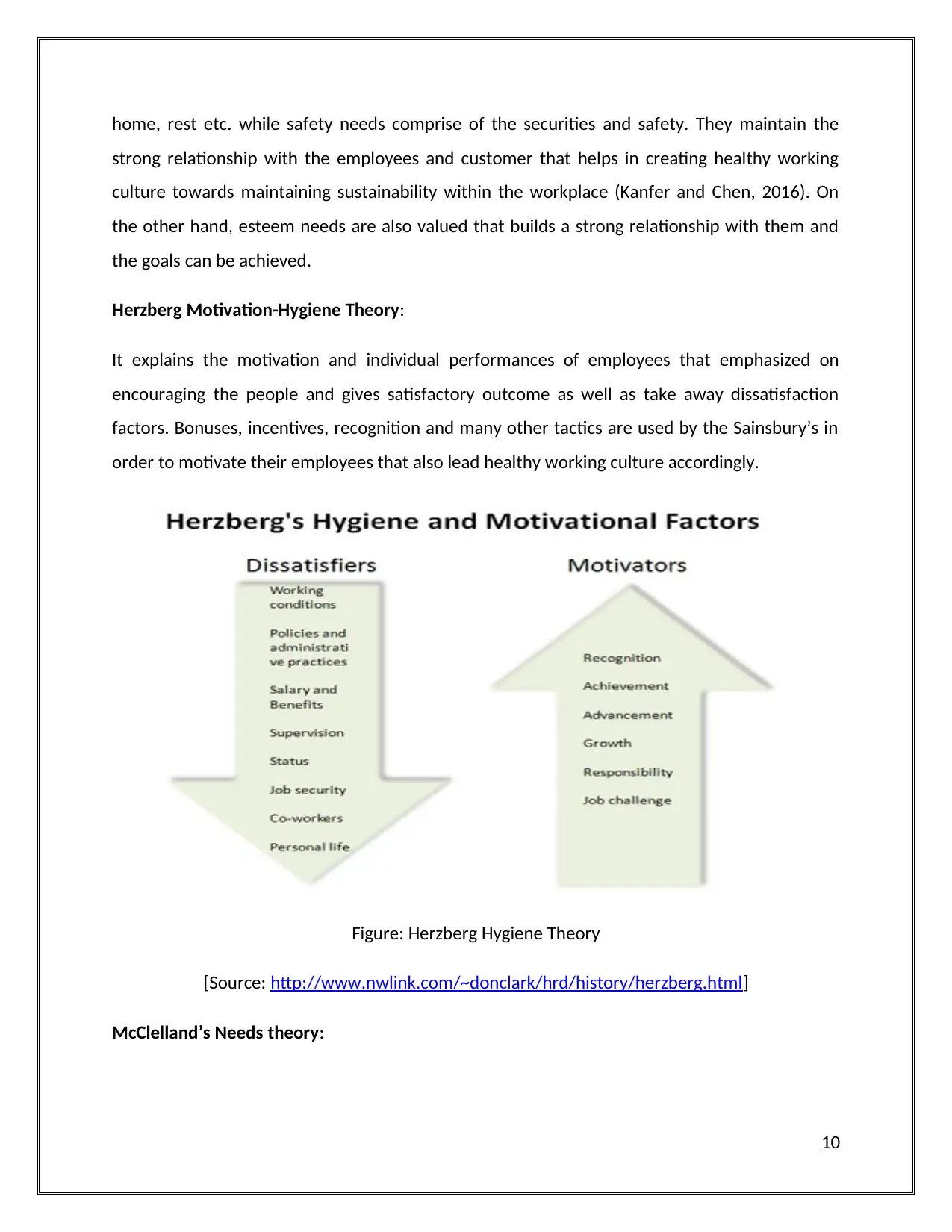
home, rest etc. while safety needs comprise of the securities and safety. They maintain the
strong relationship with the employees and customer that helps in creating healthy working
culture towards maintaining sustainability within the workplace (Kanfer and Chen, 2016). On
the other hand, esteem needs are also valued that builds a strong relationship with them and
the goals can be achieved.
Herzberg Motivation-Hygiene Theory:
It explains the motivation and individual performances of employees that emphasized on
encouraging the people and gives satisfactory outcome as well as take away dissatisfaction
factors. Bonuses, incentives, recognition and many other tactics are used by the Sainsbury’s in
order to motivate their employees that also lead healthy working culture accordingly.
Figure: Herzberg Hygiene Theory
[Source: http://www.nwlink.com/~donclark/hrd/history/herzberg.html]
McClelland’s Needs theory:
10
strong relationship with the employees and customer that helps in creating healthy working
culture towards maintaining sustainability within the workplace (Kanfer and Chen, 2016). On
the other hand, esteem needs are also valued that builds a strong relationship with them and
the goals can be achieved.
Herzberg Motivation-Hygiene Theory:
It explains the motivation and individual performances of employees that emphasized on
encouraging the people and gives satisfactory outcome as well as take away dissatisfaction
factors. Bonuses, incentives, recognition and many other tactics are used by the Sainsbury’s in
order to motivate their employees that also lead healthy working culture accordingly.
Figure: Herzberg Hygiene Theory
[Source: http://www.nwlink.com/~donclark/hrd/history/herzberg.html]
McClelland’s Needs theory:
10

It stated that there are majorly three characters, which every person needs to drive their
motivators such as needs for achievement, affiliation and the power (Kitchin, 2017). These are
not inherent and it is developed for improving the working culture and structure.
Figure: McClelland’s Theory Model
[Source: https://businessjargons.com/mcclellands-needs-theory.html]
Alderfer’s ERG Theory:
It categorized intro parts such as growth needs, relatedness and the existing needs that carry
values and overlapping with the physiological, security and social needs. It is the condensed
form of Maslow’s Needs theory.
Figure: ERG Theory
11
motivators such as needs for achievement, affiliation and the power (Kitchin, 2017). These are
not inherent and it is developed for improving the working culture and structure.
Figure: McClelland’s Theory Model
[Source: https://businessjargons.com/mcclellands-needs-theory.html]
Alderfer’s ERG Theory:
It categorized intro parts such as growth needs, relatedness and the existing needs that carry
values and overlapping with the physiological, security and social needs. It is the condensed
form of Maslow’s Needs theory.
Figure: ERG Theory
11
⊘ This is a preview!⊘
Do you want full access?
Subscribe today to unlock all pages.

Trusted by 1+ million students worldwide
1 out of 31
Related Documents
Your All-in-One AI-Powered Toolkit for Academic Success.
+13062052269
info@desklib.com
Available 24*7 on WhatsApp / Email
![[object Object]](/_next/static/media/star-bottom.7253800d.svg)
Unlock your academic potential
Copyright © 2020–2025 A2Z Services. All Rights Reserved. Developed and managed by ZUCOL.





